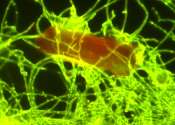Astronomers uncover risks to planets that could host life
Astronomers have discovered that red dwarf stars can produce stellar flares that carry far-ultraviolet (far-UV) radiation levels much higher than previously believed.

Astronomers have discovered that red dwarf stars can produce stellar flares that carry far-ultraviolet (far-UV) radiation levels much higher than previously believed.
Astronomy
Aug 5, 2024
0
185

Melanin protects the skin—the body's largest organ and a vital component of the immune system—from the damaging effects of ultraviolet (UV) radiation. When the skin is exposed to UV radiation, melanin production is stimulated ...
Molecular & Computational biology
Aug 5, 2024
0
0

Ultraviolet (UV) radiation can break most of the chemical bonds in organic matter, and prolonged exposure to ultraviolet light can cause significant harm to humans and objects. In response, UV-shielding materials have been ...
Optics & Photonics
Jul 30, 2024
0
1

In a revelation that highlights the fragile balance of our planet's atmosphere, scientists from China, Germany, and the U.S. have uncovered an unexpected link between massive wildfire events and the chemistry of the ozone ...
Earth Sciences
Jul 12, 2024
0
353

In a recent study, researchers at Johns Hopkins Medicine suggest that the cell's messenger RNA (mRNA)—the major translator and regulator of genetic material—along with a critical protein called ZAK—spurs the cell's ...
Cell & Microbiology
Jul 2, 2024
0
68

A fungus living in the sea can break down the plastic polyethylene, provided it has first been exposed to UV radiation from sunlight. Researchers from, among others, NIOZ published their results in the journal Science of ...
Cell & Microbiology
Jun 3, 2024
0
216

The Tibetan Plateau (TP) has the third-largest number of glaciers after the Antarctic and Greenland. Bacteria, deposited on glacier surfaces through dry and wet deposition, undergo in-situ growth and are subsequently preserved ...
Earth Sciences
May 17, 2024
0
1

Star and planet formation is a messy affair. It starts with the gravitational collapse of a gigantic cloud of gas and dust, which simultaneously produces massive stars, whose intense radiation field creates a harsh environment, ...
Astronomy
May 14, 2024
0
87

Although Mars presents a barren, dusty landscape with no signs of life so far, its geological features such as deltas, lakebeds, and river valleys strongly suggest a past where water once flowed abundantly on its surface. ...
Astrobiology
May 13, 2024
0
311

Over the last 25 years, the ozone hole which forming over Antarctica each spring has started to shrink.
Ecology
Apr 28, 2024
0
26
Ultraviolet (UV) light is electromagnetic radiation with a wavelength shorter than that of visible light, but longer than x-rays, in the range 10 nm to 400 nm, and energies from 3 eV to 124 eV. It is so named because the spectrum consists of electromagnetic waves with frequencies higher than those that humans identify as the color violet.
UV light is found in sunlight and is emitted by electric arcs and specialized lights such as black lights. As an ionizing radiation it can cause chemical reactions, and causes many substances to glow or fluoresce. Most people are aware of the effects of UV through the painful condition of sunburn, but the UV spectrum has many other effects, both beneficial and damaging, on human health.
This text uses material from Wikipedia, licensed under CC BY-SA